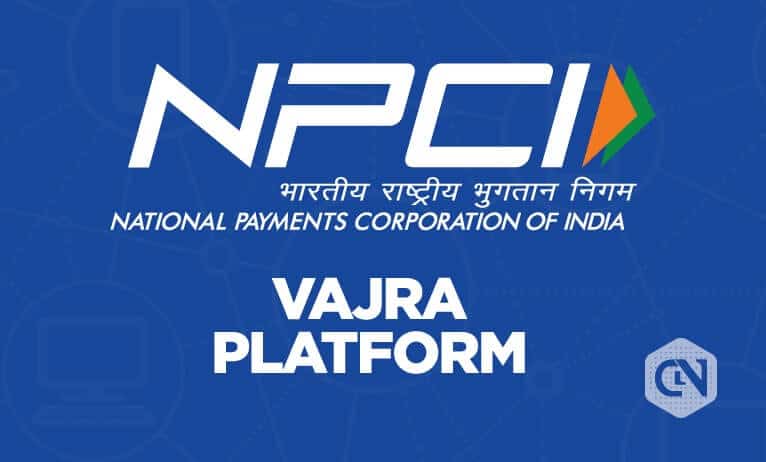Blockchain has been creating quite a stir across all sectors of industries in India since its inception. Based on the number of patents in the blockchain space, India stands 6th on the list. As such, blockchain is still in its budding stage, but Bitcoin has become quite popular in the Indian markets.
NPCI or the national payments corporation of India set up under the guidance of RBI (Reserve Bank of India) and IBA (Indian Bank Association) is an apex organization responsible for all retail payments of the nation. NPCI has recently introduced the blockchain DLT (distributed ledger technology) based Vajra platform to ease out the payment and settlement processes. After a lot of research done by NPCI, it has brought in the DLT technology to provide for a highly secure and tamper-proof immutable database for the various payment procedures. NPCI now mulls up to introduce the DLT based blockchain solutions to bring in automated payment and clearing systems. As such, the organization said in a notification, “NPCI intends to develop a resilient, real-time and highly scalable blockchain solution. It is proposed to develop this solution using an open-source technology/ framework/solution.”
The Vajra Platform
NPCI has recently set up the blockchain-based automated payment system and named it the “Vajra platform.” In this platform, only the registered parties under the network administrator can be part of the blockchain network. The Vajra platform aims at ensuring the minimal processing time that is required for reconciliation, faster dispute resolution, and secure implementation of cryptography. All these, in turn, aims to increase the security of payment processes by reaping the maximum benefits of blockchain technology. Multiple payment entities will be accessing the Vajra platform via web interfaces. The bank nodes will receive all the payment requests and will be processing them on Vajra. There will be self-executing contracts with some predefined rules and conditions. Whenever the conditions are met, the payment processes will be automatically generated on Vajra and the on-chain data will be added to the DLT database.
All the registered participants need to carry a node in the network and data will be accessible only to that particular node. There are three types of nodes as specified by NPCI; namely, Clearing House node (CHN) specified for NPCI, UIDAI node that is specified for Aadhaar authentication and applicable only for biometric authentication, and the Participant node (PN) specified for all banks/ASP/PPI/PSP.
Benefits of Vajra
The blockchain-based Vajra platform has brought in seamless benefits in the payment industry. Some of the benefits are discussed hereunder.
Transparency
The blockchain-based platform provides real-time visibility of the transaction, thereby reducing the chances of disputes to a manifold. Back-end operations have also improved subsequently after the implementation of the DLT based blockchain technology for payments.
Node processing
Advertisement
Unlike manual processing and reconciliation that involves huge processing time and also have huge chances of error, data stored in the nodes provide error-free and fast processing of payments and also eases out the task of reporting and reconciliation. It also reduces the overall processing time and the cost of operations.
Data Security
The selective visibility of the data only to the registers parties across the nodes ensures high levels of security across the network. The elimination of unrelated parties also reduces the risk and possible chances of disputes.
Features of Vajra
Controlled access
Each external party interacting with the Vajra platform is authenticated by the nodes. This defined security feature ensures higher levels of risk management and data security.
Dispute management
The transparency of the DLT helps to track complaints and address them easily. It transfers the queries to the related department. Queries may include technical declines, technical errors, and even business declines for proper dispute handling.
Notifications
This feature is used for any kind of communication between the various nodes on the network. The few categories of notifications are:
- Admin: NDC limits, Network alerts, etc.
- Transactions: Debit, Credit, Reversal, Credit adjustment etc.
- Node: Broadcasting keys and node status etc.
- Error notifications: Transaction fail, Node not responding, etc.
- Dispute Notifications: Raise dispute, Raise chargeback, etc.
Board Participation Node
New nodes can be added to the Vajra platform after the authentication from the admin node. There are specific steps to add nodes on the Vajra platform. Like Node setup, Node Identity, and Node configuration. For setting up additional nodes, it needs HA setup, DLT software installation, and Convertor application setup. For establishing the node identity, it needs the node’s credentials. Finally, for configuring the nodes, it needs setup access rights, off-chain DB integration and Node certification.
Security and Privacy of Nodes on Vajra
Advertisement
The DLT protocols for the security and privacy of nodes on Vajra are listed hereunder.
Security
- Cryptography security will be used for data protection on the Vajra platform.
- Only parties who are authorized by the Network administrator are allowed to join the Vajra platform.
- Validating nodes are allowed to enter the Vajra platform only after passing all the required security authentication.
- Primary and secondary nodes on Vajra eliminates all external parties impersonating any of the nodes, thereby ensuring data security on Vajra.
Privacy
- All transactions are encrypted by digital signatures to prevent unauthorized parties from corrupting the data, even any kinds of communication between Vajra and the external users are encrypted.
- Off-chain DB is used to store confidential data. The identities of the nodes are kept confidential.
Therefore, the Vajra platform promotes transparency by bringing in real-time visibility in payment transactions. It reduces the payment processing and settlement time. It eases out the reconciliation processes and thus promotes validated reporting. NPCI deals with permission-based blockchain and it excludes permission less participants and therefore, unrelated parties dealing with the payment clearing systems are left out.







